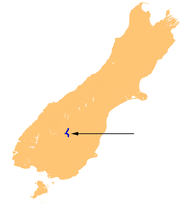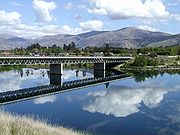
Lake Dunstan
Encyclopedia


South Island
The South Island is the larger of the two major islands of New Zealand, the other being the more populous North Island. It is bordered to the north by Cook Strait, to the west by the Tasman Sea, to the south and east by the Pacific Ocean...
of New Zealand
New Zealand
New Zealand is an island country in the south-western Pacific Ocean comprising two main landmasses and numerous smaller islands. The country is situated some east of Australia across the Tasman Sea, and roughly south of the Pacific island nations of New Caledonia, Fiji, and Tonga...
.
The lake was formed on the Clutha River
Clutha River
The Clutha River / Mata-Au is the second longest river in New Zealand flowing south-southeast through Central and South Otago from Lake Wanaka in the Southern Alps to the Pacific Ocean, south west of Dunedin. It is the highest volume river in New Zealand, and the swiftest, with a catchment of ,...
as a result of the construction of the Clyde Dam
Clyde Dam
The Clyde Dam, New Zealand's third largest hydroelectric dam, is built on the Clutha River near the town of Clyde. It is owned and operated by Contact Energy.-History:...
, filling in four controlled stages beginning in April 1992 and completed the next year. Parts of the town of Cromwell
Cromwell, New Zealand
Cromwell is a town in Central Otago in the Otago region of New Zealand.It is situated between State Highway 6 and State Highway 8 leading to the Lindis Pass, 75 km northeast, and Alexandra, 33 km south. The road to Alexandra winds through the Cromwell Gorge...
were relocated to a new area above the new lake.
Lake Dunstan provides irrigation for nearby stone fruit orchards and vineyard
Vineyard
A vineyard is a plantation of grape-bearing vines, grown mainly for winemaking, but also raisins, table grapes and non-alcoholic grape juice...
s, and is a major recreational asset, with facilities for boat
Boat
A boat is a watercraft of any size designed to float or plane, to provide passage across water. Usually this water will be inland or in protected coastal areas. However, boats such as the whaleboat were designed to be operated from a ship in an offshore environment. In naval terms, a boat is a...
ing waterskiing, fishing
Fishing
Fishing is the activity of trying to catch wild fish. Fish are normally caught in the wild. Techniques for catching fish include hand gathering, spearing, netting, angling and trapping....
, parapenting, and rowing
Sport rowing
Rowing is a sport in which athletes race against each other on rivers, on lakes or on the ocean, depending upon the type of race and the discipline. The boats are propelled by the reaction forces on the oar blades as they are pushed against the water...
.
The dam and lake became well known in New Zealand
New Zealand
New Zealand is an island country in the south-western Pacific Ocean comprising two main landmasses and numerous smaller islands. The country is situated some east of Australia across the Tasman Sea, and roughly south of the Pacific island nations of New Caledonia, Fiji, and Tonga...
due to media coverage of the geological problems during its construction. While the dam was being built at least one landslide occurred at Cairnmuir, a series of bluffs overlooking the gorge where the dam was built. All parties involved denied responsibility for not finding the problem.
Because of the expense of stabilising the gorge walls and the changing economic climate, this was also the last of Robert Muldoon
Robert Muldoon
Sir Robert David "Rob" Muldoon, GCMG, CH served as the 31st Prime Minister of New Zealand from 1975 to 1984, as leader of the governing National Party. Muldoon had been a prominent member of the National party and MP for the Tamaki electorate for some years prior to becoming leader of the party...
's Think Big
Think Big
The New Zealand Prime Minister Robert Muldoon and his New Zealand National Party government in the early 1980s sponsored Think Big as an interventionist state economic strategy. The Think Big schemes saw the government borrow heavily overseas, running up a large external deficit, and using the...
projects.
Protests
There was a vocal protest against the project from the local community, with outcries for the planning and project to cease. Environmentalists, scientists, lawyers, recreational river users, families that had lived here for generations, and others that had recently moved to the area, all protested, and among the voices, none seemed more poignant than the artists.There was a perception that the power from the dam was intended for an aluminium smelter near Dunedin. Prominent figures including Ralph Hotere
Ralph Hotere
Hone Papita Raukura "Ralph" Hotere is a New Zealand artist of Māori descent . He was born in Mitimiti, Northland and He is widely regarded as one of New Zealand's most important living artists...
, Andrew Drummond
Andrew Drummond (artist)
Andrew Drummond is a New Zealand painter and sculptor. Born in 1951 in Nelson, New Zealand, he attended University of Waterloo in Canada, graduating in 1976. He was a Frances Hodgkins Fellow in 1980....
, Chris Cree-Brown and Chris Booth made significant and powerful work that related to the smelter issue, they gained publicity and acclaim with exhibitions and appropriate comment in various art magazines. Other artists worked with the dam issue: Robin Morrison
Robin Morrison
Robin Morrison was a New Zealand documentary photographer, best known for his unpretentious portrayal of New Zealand countryside, everyday life and quirky architecture....
created a sensitive series of portraits on the residents effected by the flooding; Marilynn Webb a compelling series of prints called "Good Bye- Clutha Blue" in 1983; Bruce Foster a series of Ciba-chrome prints investigating the pre-construction lines painted on the land, and Lloyd Godman a significant series of large photo-mural prints gold toned with gold from the Clutha river titled “The Last Rivers Song”. During the filling of the dam to form Lake Dunstan in 1992 - 93 Godman also completed a series of performance works titled "Lake Fill" which involved taking a series of photographs with an underwater camera of a selected vista looking up the river which was gradually obliterated due to the rising lake level.

